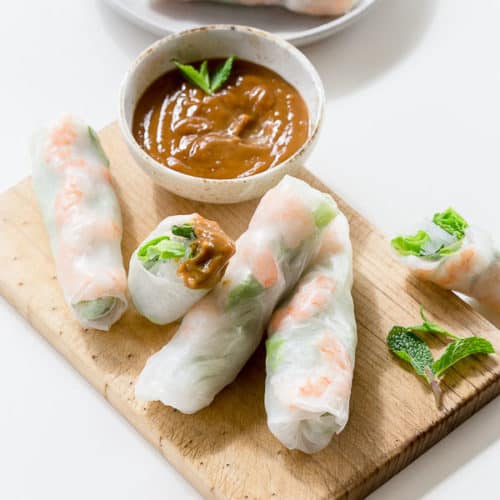Ah, rice paper rolls! The epitome of fresh, delightful bites that transport your senses straight to the heart of Southeast Asia. This wholesome delicacy, light yet packed with flavors, can be an appetizer or the main course, depending on your appetite. Dive into our comprehensive guide and discover the intricate dance of ingredients that make rice paper rolls an eternal favorite.
Origins: A Journey Back In Time
Rice paper rolls, also known as spring rolls in certain regions, boast a deep-rooted history in Asian cuisine. Originating from Vietnam, these rolls have garnered immense popularity across the globe. Their evolution is a testament to the age-old tradition of wrapping meats and vegetables in rice paper and savoring the blend of textures and flavors.
The Foundation: Rice Paper
The soul of any rice paper roll is, unsurprisingly, the rice paper itself. It’s a delicate, thin, translucent sheet made primarily from rice flour and water. This edible paper serves as the perfect canvas for the medley of ingredients that nestle within.
Selecting the perfect rice paper
- Transparency: Look for slightly transparent sheets. The clarity is an indicator of quality and freshness.
- Flexibility: The best rice paper should be pliable without being too sticky. This ensures easy rolling without tearing.
- Diameter: A standard size for most rolls is around 22 cm in diameter. However, sizes may vary based on your preference.
The Filling: Where Magic Happens
While the rice paper is crucial, the fillings are the real stars. They bring to life the myriad flavors and textures that rice paper rolls are celebrated for.
Protein choices
- Prawns: Fresh, succulent prawns are a classic choice. Ensure they’re deveined and poached to perfection.
- Chicken: Thin slices of poached or grilled chicken can offer a hearty touch.
- Tofu: For a vegetarian or vegan variant, firm tofu, lightly pan-seared, is an excellent addition.
Vibrant vegetables
- Lettuce: A crispy base that provides crunch and freshness.
- Cucumber: Thin slices add a refreshing bite.
- Carrot: Julienne or thinly sliced, these add color and a touch of sweetness.
- Herbs: Mint, cilantro, and basil. Their inclusion elevates the rolls to a symphony of flavors.
Rolling Technique: The Art Of Perfection
Rolling rice paper rolls might seem daunting, but with a little patience and practice, you’ll master the art.
- Hydrate the Rice Paper: Dip each rice paper sheet in warm water until it’s pliable, typically for about 10-15 seconds.
- Layout Ingredients: On a flat surface, lay out the softened rice paper. Begin with lettuce at the base, followed by proteins and vegetables.
- Fold and Roll: Fold the sides of the rice paper inward, then roll from the bottom up, ensuring the ingredients stay snug within.
Complementary Dips: The Final Touch
No rice paper roll is complete without its accompanying dip. Popular choices include:
- Hoisin-Peanut Sauce: A rich blend of hoisin sauce, crushed peanuts, and a hint of chili.
- Fish Sauce Dip: A tangy mix of fish sauce, garlic, chili, and a sprinkle of sugar.
- Ginger-Soy Dip: A zesty combination of soy sauce, freshly grated ginger, and a dash of sesame oil.
Benefits: More Than Just Taste
Rice paper rolls are not only tantalizing to the palate but also offer several health benefits:
- Low Caloric Content: Due to the fresh ingredients and minimal use of oil.
- Rich in Protein: Especially when filled with seafood or chicken.
- Vitamins and Minerals: Thanks to the plethora of vegetables and herbs.
Storing And Serving
Rice paper rolls are best enjoyed fresh. However, if you must store them:
- Place them side by side in an airtight container, ensuring they don’t stick.
- Serve at room temperature or slightly chilled.
In Conclusion
Rice paper rolls are a harmonious blend of textures and flavors, encapsulating the essence of Asian cuisine. They offer a delightful gastronomic experience, promising freshness in every bite. Whether you’re a novice or a culinary expert, crafting these rolls is a rewarding endeavor.
FAQs
1. Can I add noodles to my rice paper rolls?
Absolutely! Vermicelli noodles are a popular addition, offering a pleasant chewy texture.
2. How long can I store rice paper rolls?
Ideally, they’re best consumed within a day. However, with proper storage in a refrigerator, they can last up to two days.
3. Can I deep-fry these rolls?
While traditional rice paper rolls are served fresh, they can be deep-fried for a crispier variant known as fried spring rolls.

